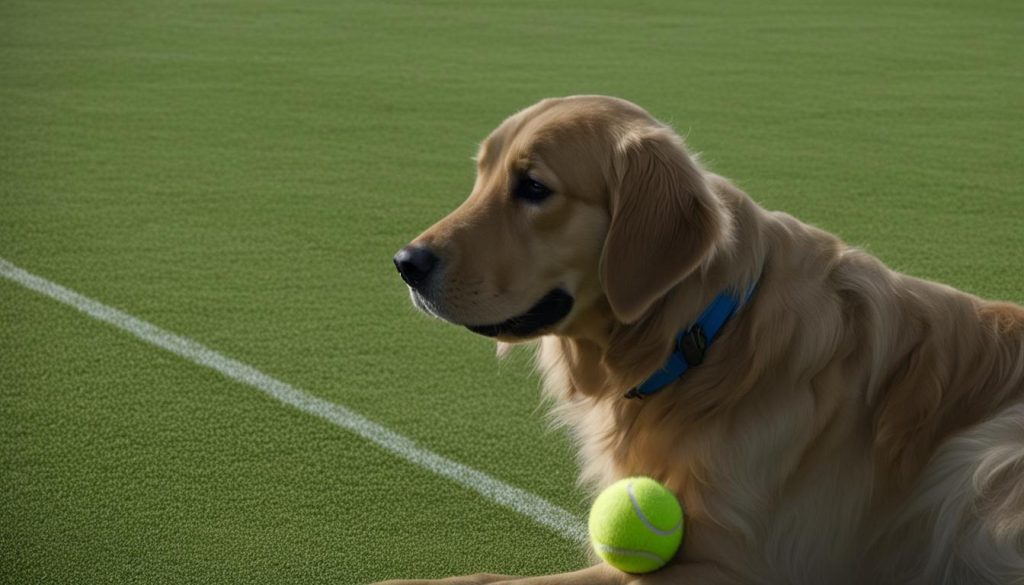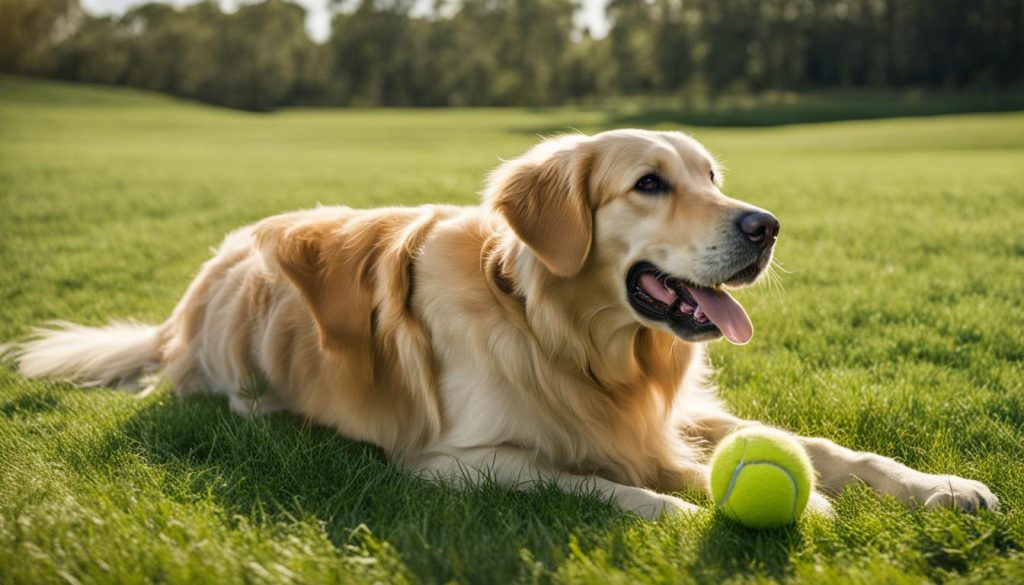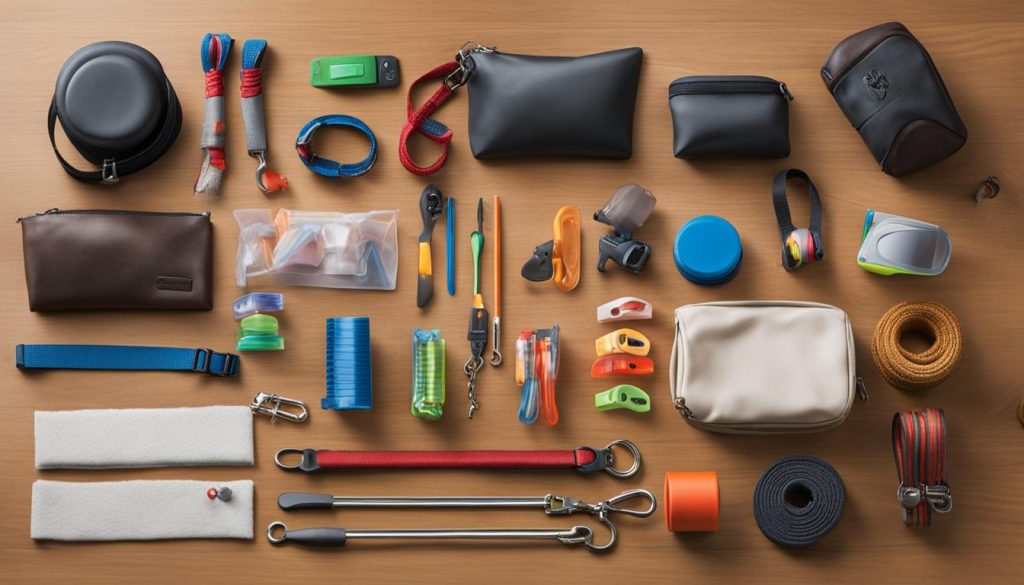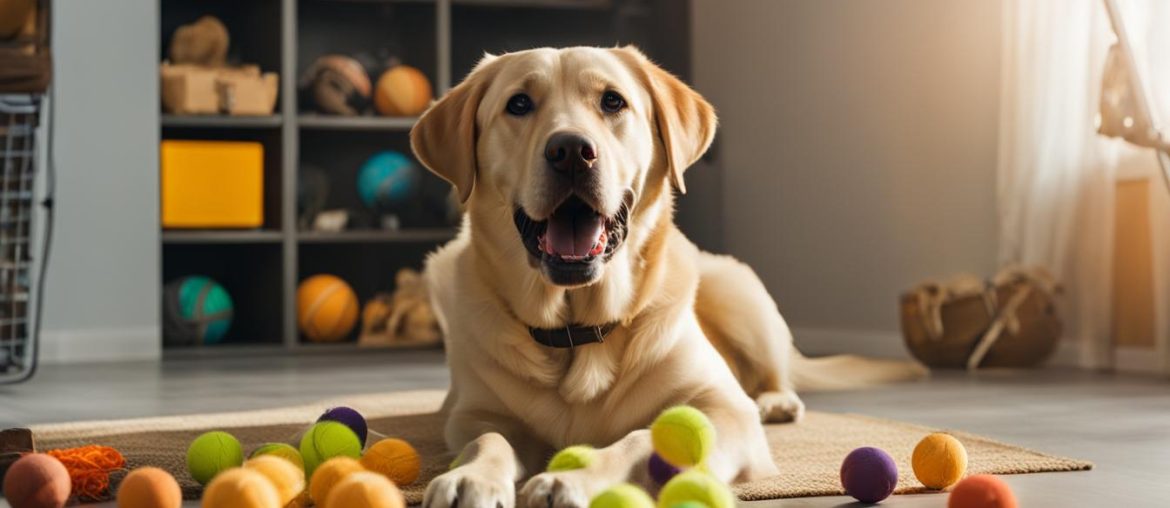Teaching your dog to hold an object is a valuable skill that can be built upon for advanced behaviors in dog sports, such as retrieving. This command not only enhances their obedience but also opens up opportunities for fun and practical tasks. Whether you want your dog to carry their toy or assist you with small tasks, teaching them to hold objects is a rewarding and essential training exercise.
In this article, I will guide you through the step-by-step process of teaching your dog to hold an object using positive reinforcement. I will also provide specific tips for training older dogs, discuss the importance of holding objects in dog sports, and share troubleshooting strategies for a successful training journey.
Key Takeaways:
- Teaching your dog to hold an object is a valuable skill that can be used for advanced behaviors in dog sports.
- Start by choosing a preferred object and using positive reinforcement to encourage your dog’s interest in it.
- Gradually increase the criteria, rewarding your dog for mouthing and eventually holding the object.
- Be consistent and patient throughout the training process, ending each session on a positive note.
- Adapt the training for older dogs and consider their specific needs, such as dental issues or impairments.
Step-by-Step Instructions for Teaching Your Dog to Hold an Object
Teaching your dog to hold an object is a fundamental skill that can be built upon for advanced behaviors in dog training. By following these step-by-step instructions, you can effectively teach your dog the hold command using positive reinforcement training.
Step 1: Present the object and ask your dog to “pick it up.”
Start by selecting a preferred object for your dog to hold, such as a retrieval bumper or a stuffed toy. Hold the object in front of your dog’s nose to pique their interest.
Step 2: Reward them when they touch or hold the object.
As soon as your dog shows any interest in the object, whether by touching it with their nose or attempting to grab it, immediately click or say “good” and reward them with a treat. Repeat this several times to reinforce the behavior.
Step 3: Repeat this several times to reinforce the behavior.
Continue practicing steps 1 and 2, gradually increasing the criteria for the behavior. Encourage your dog to touch and hold the object for longer durations before rewarding them.
Step 4: Gradually increase the time your dog holds the object.
Once your dog is consistently touching and holding the object, start adding the verbal cue “hold” when they pick it up. Say “hold” as your dog grabs the object and reinforce the behavior with a reward.
Step 5: Do not reward pushing or chewing of the object.
Be sure to only reward your dog when they are calmly holding the object in their mouth. If they push or chew on the object, gently remove it and restart the training process.
Step 6: Support your dog less when they hold it correctly.
Gradually decrease the support you provide to your dog while they hold the object. Initially, you may need to hold the object lightly while they grip it, but over time, reduce your support to encourage independent holding.
Step 7: Once your dog can hold it on their own, reward them immediately.
When your dog can confidently hold the object without your support, reward them immediately with a click or a verbal cue followed by a treat. This reinforces their successful completion of the hold command.
Step 8: Increase the duration before rewarding to build up their holding time.
As your dog becomes more proficient in holding the object, gradually increase the duration they must hold it before receiving a reward. This helps build their endurance and strengthens their ability to hold objects for longer periods.
Step 9: Be consistent with using the same object during training.
Throughout the training process, use the same object consistently. This helps your dog associate the command and behavior with that specific object, making it easier for them to understand and execute the hold command in different situations.

By following these step-by-step instructions and utilizing positive reinforcement training techniques, you can successfully teach your dog to hold an object. Try to be patient, consistent, and reward your dog for their progress. With practice and repetition, your dog will become proficient in this valuable skill.
Training Tips for Older Dogs
When training an older dog to hold an object, there are a couple of additional considerations. First, make sure the object doesn’t cause any pain or discomfort, especially if the dog has dental issues. Second, adapt the training for dogs with hearing or vision impairments by using visual hand signals or allowing extra time for sniffing the objects.
Most dogs can learn this skill with consistent practice, but it may take one to three weeks. Use their favorite treats and choose calm locations for training.
Training Tips for Older Dogs
- Ensure the object doesn’t cause pain or discomfort
- Adapt training for dogs with hearing or vision impairments
- Use visual hand signals or allow extra time for sniffing objects
- Consistent practice is key
- Use your dog’s favorite treats as rewards
- Choose calm locations for training sessions
With patience and perseverance, you can successfully teach your older dog to hold objects. Try to provide positive reinforcement and adapt the training to their specific needs. As with any training, consistency is key. Celebrate small victories along the way and enjoy the process of strengthening the bond with your furry friend.
| Training Tips for Older Dogs |
|---|
| Ensure the object doesn’t cause pain or discomfort |
| Adapt training for dogs with hearing or vision impairments |
| Use visual hand signals or allow extra time for sniffing objects |
| Consistent practice is key |
| Use your dog’s favorite treats as rewards |
| Choose calm locations for training sessions |

Importance of Holding Objects for Dog Sports
Teaching your dog to hold an object lays a strong foundation for advanced behaviors in dog sports, particularly retrieving. The hold command enables dogs to carry items without dropping them, which is crucial in activities like duck hunting. It can also be used in service work, where dogs assist with carrying and grasping items. Dogs that naturally carry things in their mouths, such as Golden Retrievers and Labradors, may learn this skill more quickly.

Benefits of Holding Objects
Holding objects is a fundamental skill in dog sports, providing many benefits for both dogs and their owners. Here are a few reasons why teaching your dog to hold objects is important:
- Improved control: Holding objects allows you to have better control over your dog during activities like retrieving. They learn to carry items without dropping them, ensuring successful completion of tasks.
- Enhanced coordination: Holding objects requires dogs to use their mouths and coordinate their movements, improving their overall dexterity and physical abilities.
- Mental stimulation: Learning to hold objects engages your dog’s mind, providing them with mental stimulation and preventing boredom.
- Bonding and trust: Training your dog to hold objects strengthens the bond between you and your furry companion, as it requires trust and cooperation.
By teaching your dog to hold objects, you’re not only preparing them for dog sports but also providing them with valuable skills that can benefit their overall well-being. It’s a win-win situation for both you and your four-legged friend!
| Advantages of Holding Objects for Dog Sports | Benefits |
|---|---|
| Improved control | Ensures successful completion of tasks |
| Enhanced coordination | Improves dexterity and physical abilities |
| Mental stimulation | Engages the mind, prevents boredom |
| Bonding and trust | Strengthens the bond between dog and owner |
Using Positive Reinforcement in Training
When it comes to training your dog to hold an object, positive reinforcement is a highly effective method. By using rewards and praise to motivate your dog, you can encourage them to engage in the desired behavior. Positive reinforcement training focuses on rewarding your dog for doing the right thing, rather than punishing them for mistakes. This approach not only builds a stronger bond between you and your dog but also makes the training process more enjoyable for both of you.
When teaching your dog to hold an object, start by presenting the item and asking them to “pick it up.” When they touch or hold the object, reward them with a treat or verbal praise. Repeat this process several times, gradually increasing the duration that your dog holds the object each time. I recommend that you use consistent cues and rewards to reinforce the behavior.
In addition to treats and praise, you can also use a clicker as a marker to signal to your dog that they have performed the desired behavior. The sound of the clicker is associated with a reward, and it helps to pinpoint the exact moment your dog engages in the correct behavior. This clear communication can help your dog understand what is expected of them and accelerate their learning process.
Benefits of Positive Reinforcement Training
- Creates a positive and enjoyable training experience for your dog
- Strengthens the bond between you and your dog
- Increases your dog’s motivation to learn and participate in training
- Boosts your dog’s confidence and self-esteem
- Encourages your dog to think and problem-solve
Try to be patient and consistent in your training sessions. End each session on a positive note, and if you or your dog start to feel frustrated, take a break and come back to it later. Training your dog to hold an object takes time and practice, but with positive reinforcement, you can achieve great results and strengthen the bond with your furry companion.

Equipment and Tools for Training
When it comes to training your dog to hold an object, having the right equipment and tools can make the process smoother and more effective. Here are some essential items you’ll need:
- Leash: A leash is useful for keeping your dog close during training sessions and maintaining control.
- Treats: Small and tasty treats are excellent rewards for your dog’s successful holding behavior.
- Objects: Choose objects that are easy for your dog to hold in its mouth, such as retrieval bumpers, stuffed dog toys, or rubber chew toys.
These tools will aid in practicing the hold command and provide your dog with appropriate objects to work with. You should also select items that are safe and comfortable for your dog to hold. Avoid objects that may cause pain or discomfort, especially if your dog has dental issues.
During the initial training sessions, it’s best to choose a calm location such as your home or a fenced yard. This will minimize distractions and allow your dog to focus on the task at hand. As your dog becomes more proficient, you can gradually introduce distractions in different locations to reinforce their holding skills in various environments.
| Equipment | Usage |
|---|---|
| Leash | Provides control and keeps the dog close during training sessions. |
| Treats | Used as rewards to reinforce desired holding behavior. |
| Objects (retrieval bumpers, stuffed dog toys, rubber chew toys) | Provides appropriate items for the dog to hold during training. |
By having these training tools and using them effectively, you can provide your dog with the necessary support and resources to learn and master the hold command. Try to be patient, consistent, and always end training sessions on a positive note. With time and practice, your dog will become proficient in holding objects, opening up a world of possibilities for advanced dog training and obedience.

Benefits of Teaching your Older Dog to Hold
Teaching your older dog to hold objects can have several benefits for both you and your furry companion. This skill can assist in daily life situations, such as holding your purse while you gather your things at the pet store checkout, or carrying items for you around the house. It provides mental stimulation for your dog, keeping their mind sharp and engaged. Plus, it gives your dog a unique skill to show off and can be a great conversation starter when you’re out and about.
Training your older dog to hold objects also helps maintain their cognitive function. Engaging in new activities and learning new commands can help stave off cognitive decline, keeping your dog’s brain active and healthy. Additionally, teaching your dog new tricks strengthens the bond between you and your furry friend. It fosters trust, communication, and cooperation, creating a deeper connection and enhancing your relationship.
Incorporating hold training into your dog’s routine can be a fun and rewarding experience for both of you. Try to use positive reinforcement and plenty of treats to motivate your dog and make the learning process enjoyable. With time and practice, your older dog will become proficient in holding objects, and you’ll both reap the benefits of this valuable skill.

| Benefits of Teaching Your Older Dog to Hold | |
|---|---|
| Assists in daily life situations, such as carrying items for you | Convenience and practicality |
| Provides mental stimulation and keeps your dog’s mind sharp | Mental exercise and enrichment |
| Gives your dog a unique skill to show off | Entertainment and socialization |
| Maintains your dog’s cognitive function | Brain health and sharpness |
| Strengthens the bond between you and your dog | Trust, communication, and cooperation |
Troubleshooting and Tips for Success
Teaching your dog to hold an object may have its challenges, but with patience and persistence, you can overcome them. Here are some troubleshooting tips and suggestions to ensure your training sessions are successful:
1. Break down the training into smaller steps:
If your dog is struggling to hold the object, try breaking down the training into smaller, more manageable steps. Start by rewarding your dog for simply touching the object, then gradually increase the criteria until they can hold it for longer periods. This incremental approach can help your dog build confidence and prevent frustration.
2. Be consistent:
Consistency is key when training your dog to hold an object. Use the same command, such as “hold,” each time you ask your dog to pick up and hold the object. Consistent cues and rewards will help your dog understand what is expected of them and reinforce the desired behavior.
3. Use positive reinforcement:
Positive reinforcement is an effective training technique. Reward your dog with treats, verbal praise, or a clicker when they successfully hold the object. This positive association will motivate your dog to continue performing the behavior. Additionally, make sure to end each training session on a positive note, celebrating your dog’s progress.
4. Practice in different environments:
Once your dog can hold the object reliably in a controlled environment, gradually introduce distractions. Practice the hold command in different environments, such as a park or on walks, to help your dog generalize the skill. This will ensure that your dog can hold an object in various situations and locations.
By following these troubleshooting tips and implementing positive reinforcement techniques, you can successfully teach your dog to hold an object. Try to have patience, stay consistent, and provide plenty of practice opportunities. Celebrate your dog’s achievements along the way and enjoy the process of strengthening your bond through training.

Final Thoughts
To sum it up, teaching your dog to hold an object is an essential skill that can be developed through positive reinforcement training. By following the step-by-step instructions and adapting the training for older dogs, you can successfully teach your dog to hold objects.
This skill has practical benefits in daily life situations and can also be used in advanced dog sports, such as retrieving. Not only does it provide mental stimulation for your dog, but it also strengthens the bond between you and your furry friend.
Try to stay patient and persistent, celebrating small victories along the way. Consistency is key, so make sure to practice regularly and provide plenty of opportunities for your dog to hone their holding skills. Enjoy the journey of training your dog and watch as they proudly showcase their new skill!
FAQ
How do I teach my dog to hold an object?
To teach your dog to hold an object, start by choosing a preferred object and using positive reinforcement. Hold the object in front of their muzzle and click and treat when they show interest. Gradually increase the criteria until they start mouthing and eventually holding the object willingly.
What should I do if my dog starts pushing or chewing the object?
If your dog starts pushing or chewing the object, do not reward that behavior. Instead, wait for them to grab it willingly and then reward them. Consistency is key in reinforcing the desired behavior of holding the object.
How long will it take to teach my dog to hold an object?
The training duration can vary, but most dogs can learn this skill within one to three weeks with consistent practice. Using their favorite treats and choosing calm locations for training can help expedite the learning process.
Can I train an older dog to hold an object?
Yes, older dogs can be trained to hold objects. However, you should consider any dental issues or physical discomfort that the object may cause. Additionally, you may need to adapt the training for dogs with hearing or vision impairments by using visual cues or allowing extra time for sniffing the objects.
What are the benefits of teaching my dog to hold an object?
Teaching your dog to hold an object lays a strong foundation for advanced behaviors in dog sports, such as retrieving. It can also be useful in service work and daily life situations where dogs assist with carrying items. Training your dog to hold an object provides mental stimulation and strengthens the bond between you and your dog.
How can I troubleshoot challenges in teaching my dog to hold an object?
If you encounter challenges, stay patient and persistent. If you or your dog start feeling frustrated, end the training session on a positive note and resume later. Break down the training into smaller steps if your dog is struggling. Consistency and celebrating small victories along the way will keep both you and your dog motivated.
What tools do I need for training my dog to hold an object?
You will need a leash, small and tasty treats, and objects that can fit easily into your dog’s mouth, such as retrieval bumpers or rubber chew toys. These tools will aid in practicing the hold command. Choose a calm location for initial training sessions and gradually introduce distractions as your dog becomes proficient.
Are there any specific training tips for older dogs?
When training older dogs, consider any physical limitations they may have and ensure that the chosen object doesn’t cause pain or discomfort. Adapt the training for dogs with hearing or vision impairments by using visual cues or allowing extra time for sniffing. Consistency, patience, and positive reinforcement are key in training older dogs.
What is the importance of positive reinforcement in training?
Positive reinforcement is a highly effective training method that motivates dogs to repeat desired behaviors. By using treats, verbal praise, or a clicker to reinforce the behavior of holding an object, you can encourage your dog to continue performing that action. Consistency and patience are crucial in utilizing positive reinforcement effectively.






